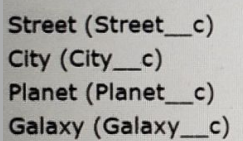At ValidExamDumps, we consistently monitor updates to the Salesforce Platform-App-Builder exam questions by Salesforce. Whenever our team identifies changes in the exam questions,exam objectives, exam focus areas or in exam requirements, We immediately update our exam questions for both PDF and online practice exams. This commitment ensures our customers always have access to the most current and accurate questions. By preparing with these actual questions, our customers can successfully pass the Salesforce Certified Platform App Builder (old) exam on their first attempt without needing additional materials or study guides.
Other certification materials providers often include outdated or removed questions by Salesforce in their Salesforce Platform-App-Builder exam. These outdated questions lead to customers failing their Salesforce Certified Platform App Builder (old) exam. In contrast, we ensure our questions bank includes only precise and up-to-date questions, guaranteeing their presence in your actual exam. Our main priority is your success in the Salesforce Platform-App-Builder exam, not profiting from selling obsolete exam questions in PDF or Online Practice Test.
What are the limitations of Schema Builder when creating a custom object?
It lacks setting up field-level security and adding fields to the page layout, so you have to choose the manual way of field creation. Adds another layer of risk with changes in Schema Builder since it is deployed in real-time.
Salesforce Schema Builder is a powerful tool for visualizing and creating objects, fields, and relationships in Salesforce, but it has certain limitations when building custom objects.
Option B (Fields and relationships can be created, but they will be unable to add the fields to the page layout from the canvas): In Schema Builder, while you can create new custom objects, fields, and relationships, you cannot directly add fields to the page layout from within the Schema Builder interface. After creating a field, you need to navigate to the Page Layout Editor to manually place the new field on the layout.
Option A: This is incorrect because you can perform multiple actions within Schema Builder without needing to click Save each time. Salesforce will save these changes when you click Save once at the end.
Option C: While relationships can be created in Schema Builder for both standard and custom objects, there is no requirement to use Lightning Object Manager to create relationships with standard objects.
Option D: Schema Builder supports the creation of formula fields along with other types of fields. There is no exclusion for formula fields.
In summary, Option B is the correct limitation of Schema Builder: you cannot add fields to page layouts directly from the Schema Builder interface.
Reference: Schema Builder Limitations
Ursa Major Solar (UMS) has a custom object where they track Galactic Vendors. The object has four custom fields for the Galactic Vendors's location:

The UMS's leadership wants these fields to be concatenated into a single formula field on two lines.
Which formula fulfills this requirement?
A)

B)

C)

D)

This formula concatenates the four custom fields for the Galactic Vendor's location into a single text value, separated by commas and spaces. The formula also uses the BR function to insert a line break after the second field, creating two lines of text. Option A, B, and D are not formulas that fulfill the requirement.
Universal Containers would like to automatically assign a specific permission set to new users. How can this requirement bemet? Choose 2 Answers
A flow or a process can be used to assign a permission set to new users.A flow can be triggered by a record change or an invocable action, while a process can launch a flow as an immediate or scheduled action
Cloud Kicks (CK) increased its Salesforce development efforts so that it now has multiple custom development efforts happening in parallel. CK's developers and admins perform the custom (rations and have complained that working in one sandbox has led to many problems. They requested a solution in which they can work in at least 20 different sandboxes at once, that all start with the same base configuration and data.
What should an app builder use to solve the problem?
Partial Copy Sandboxes are ideal for testing and development purposes as they include a subset of production data and can be refreshed more frequently than Full Copy sandboxes. References:
Salesforce Help - Types of Sandboxes
Cloud Kicks wants to efficiently Increase the company's adoption of Salesforce while simultaneously moving away from their reliance on spreadsheets. An app builder is given a spreadsheet everyone is sharing that needs to be added to Salesforce. The object with fields needs to be created and the data inserted simultaneously.
Which tool should be used?
Lightning Object Creator is a tool that allows app builders to create an object with fields and import data from a spreadsheet simultaneously. Import Wizard and Data Loader are tools for importing data into existing objects, not creating new objects. Schema Builder is a tool for creating and modifying objects and fields, but not importing data.